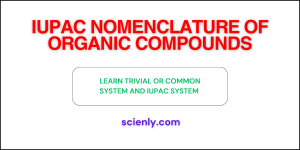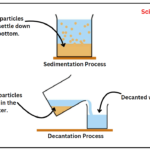Organic Chemistry: Definition & Inspiring History
In this article, we will learn about organic chemistry. We know that minerals, plants, and animals are the three major sources of naturally occurring substances. Around the year 1780, chemists mainly divided these compounds into two classes based on their sources. They are organic and inorganic compounds.
Organic compounds are those compounds which are obtained directly or indirectly from living organisms, such as plants and animals. The branch of chemistry which deals with the study of these compounds is called organic chemistry.
On the other hand, inorganic compounds are those compounds that are obtained from non-living sources such as mineral, and rocks. Examples of inorganic compounds include common salt, marble, alum, nitre, and blue and green vitriols. The branch of study which deals with the study of these compounds is called inorganic chemistry.
Organic chemistry is a vital sub-branch of chemistry that focuses on the study of the structure, properties, composition, reactions, and preparation of carbon-containing compounds. The term “organic” originally meant “derived from living organisms.” In 1808, Jöns Jakob Berzelius defined organic chemistry as the chemistry of substances found in living matter and proposed the vital force theory.
The first organic compound synthesized in the laboratory was urea, prepared by Friedrich Wöhler in 1828. This marks a significant breakthrough in the field of organic chemistry.
Table of Contents
History of Organic Chemistry
Organic chemistry is the branch of chemistry which deals with the study of carbon and its compounds. Its history is a rich and fascinating that spans centuries. Here is a timeline highlighting key events in the history of organic chemistry:
1. Vital Force Theory
Until the early 19th century, it was believed that organic compounds could not be prepared in the laboratory. They could only be obtained from plants and animals. Based on this belief, a Swedish chemist, Jöns Jakob Berzelius, proposed Vital Force Theory in 1815. According to this theory, organic compounds are produced only under the influence of a mysterious force present in the living organisms. This mysterious force was called vital force.
Since this mysterious force was thought to exist only in living beings and could not be created artificially, it was believed to be impossible to synthesize organic compounds in the laboratory. This theory was widely accepted and dominated scientific thought for many years. Thus, Berzelius formally introduced the idea of organic chemistry as the study of compounds derived from living organisms.
2. Breakthrough: Wohler’s Synthesis of Urea
The turning point in the history of organic chemistry came in 1828 when Friedrich Wohler, a German chemist, made an interesting discovery. He accidentally obtained or synthesized urea. This is a well known organic compound found in the urine of man and other mammals by evaporating an aqueous solution of ammonium cyanate. It is a typical inorganic compound which is obtained by double decomposition of ammonium chloride and potassium cyanate.

This synthesis disproved the vital force theory and clearly demonstrated that no mysterious force is required to form organic compounds in the laboratory. It showed that organic compounds can be created from inorganic substances. This discovery marked the beginning of modern organic chemistry.
3. Rapid Development in the 19th Century
After the discovery of an organic compound urea by Wohler, scientists became more interested in how organic compounds are built and how they react.
- Justus von Liebig and Jean-Baptiste Dumas helped explain how organic reactions work and how molecules are structured.
- The idea of functional groups was introduced. This helped scientists to group organic compounds based on the parts of the molecule that react.
- In 1845, Hermann Kolbe synthesized acetic acid, and in 1856, Marcellin Berthelot synthesized methane.
- In 1858, August Kekulé proposed that carbon can form four bonds. This concept is known as tetravalency.
- He also introduced structural formulas, which are simple representations showing how atoms are connected in a molecule.
4. Discovery of the Benzene Ring
Another major breakthrough came in 1865, when Kekulé discovered the structure of benzene. He proposed that benzene has a cyclic structure with alternating double bonds, a theory that was later confirmed by more accurate models. This discovery led to the development of aromatic chemistry, which is an important branch of organic chemistry.
5. Organic Chemistry in the 20th Century
During the 20th century, a tremendous growth saw in organic chemistry:
- The invention of spectroscopic techniques, such as IR (Infrared Spectroscopy), NMR (Nuclear Magnetic Resonance), and Mass Spectrometry, helped chemists to determine the structure of complex molecules.
- Organic chemistry played a central role in the development of:
- Pharmaceuticals (e.g., aspirin, penicillin)
- Polymers (e.g., nylon, plastic)
- Dyes and pigments
- Fuels and petrochemicals
Famous chemists like Robert Burns Woodward made significant contributions by synthesizing complex natural products such as vitamin B12 and chlorophyll. He was awarded the Nobel Prize in Chemistry in 1965.
Modern Definition of Organic Chemistry
Lavoisier was the first to analyze organic compounds and discovered that all organic compounds, whether natural or synthetic, contain carbon and hydrogen, and sometimes a few other elements such as oxygen, nitrogen, sulfur, halogens, and phosphorus.
Thus, the modern definition of organic chemistry is:
Organic chemistry is the branch of chemistry that deals with the study of the structure, properties, composition, reactions, and preparation of carbon-containing compounds. These compounds usually contain carbon and hydrogen, along with one or more additional elements, such as oxygen, nitrogen, sulfur, halogens, phosphorus, etc.

Carbon is an essential constituent of all such compounds. Thus, organic chemistry is defined as the study of compounds that contain carbon. However, some carbon compounds such as carbon monoxide (CO), carbon dioxide (CO₂), carbonic acid (H₂CO₃), metal carbonates, metal carbonyls, carbides, and cyanides are still studied under inorganic chemistry because they have greater resemblance to inorganic compounds.
Nowadays, organic chemistry is precisely defined as the study of hydrocarbons and their derivatives.
Organic Chemistry As Separate Branch of Chemistry
Soon after the fall of the vital force theory, it became clear that there is no fundamental difference between organic and inorganic compounds based on their origin or method of formation. However, organic compounds possess several striking features or characteristics that justify treating organic chemistry as a separate branch of chemistry. The important reasons for treating organic chemistry as separate branch are as follows:
1. Number of organic compounds:
There are about five million organic compounds known at present and many more being added every year. This large number of organic compounds is due to the unique property of carbon atoms to combine with other carbon atoms to form long chains and rings. This self-linking ability of carbon atoms is called catenation. Because of this, the number of carbon compounds is extremely high.
If more than five million compounds of carbon are added to the carbon chapter under general chemistry alone, the study of chemistry would be unbalanced. Therefore, organic chemistry is treated as a separate and essential branch of chemistry.
2. Composition:
Organic compounds are generally composed of only a few elements, mainly carbon and hydrogen, along with oxygen, nitrogen, halogens (like chlorine and bromine), sulfur, and phosphorus. For example:
- Methane (CH₄) – contains carbon and hydrogen
- Ethanol (C₂H₅OH) – contains carbon, hydrogen, and oxygen
- Chloroform (CHCl₃) – contains carbon, hydrogen, and chlorine
On the other hand, inorganic compounds may contain any two or more than two of various known elements from the periodic table. For example:
- Sodium chloride (NaCl) – contains sodium and chlorine.
- Copper sulfate (CuSO₄) – contains copper, sulfur, and oxygen.
- Potassium dichromate (K₂Cr₂O₇) – contains potassium, chromium, and oxygen.
3. Complexity of organic molecules:
Although organic compounds are composed of few elements yet many of organic molecules have complex structures and very high molecular masses. For example:
- Starch has the molecular formula (C₆H₁₀O₅)ₙ, where n may be several thousand.
- Molecules of proteins, such as hemoglobin, are made up of thousands of atoms and have intricate three-dimensional structures. Their molecular masses can range from a few thousand to over a million.
- DNA (Deoxyribonucleic Acid) is another complex organic molecule that carries genetic information and has an extremely high molecular mass.
4. Non-ionic character of organic compounds:
Organic compounds are generally covalent in nature because they are made up of covalent bonds. Therefore, they usually do not undergo ionic reactions. In contrast, inorganic compounds are often ionic and readily participate in ionic reactions. For example:
- Chloroform (CHCl₃) is an organic compound and does not react with silver nitrate (AgNO₃) to form a precipitate.
- Sodium chloride (NaCl) is an inorganic ionic compound and gives a white precipitate of silver chloride (AgCl) when treated with silver nitrate.
5. Stability:
In general, organic compounds are relatively less stable than inorganic compounds. Organic compounds usually decompose upon heating, and in some cases, decomposition can begin even below room temperature.
6. Isomerism:
Isomerism is a phenomenon in which two or more compounds have the same molecular formula but different structures and properties. It is very common in organic compounds. For example, the molecular formula C₂H₆O represents two different compounds:
- CH₃OCH₃ (dimethyl ether)
- C₂H₅OH (ethanol)
These compounds have different structures and distinct physical and chemical properties. The compounds which have the same molecular formula but different structures are called isomers. Thus, n-butane and iso-butane are isomers. In contrast, inorganic compounds generally do not exhibit isomerism to the same extent.
7. Melting and boiling points:
Organic compounds usually have low melting and boiling points due to their covalent nature and the presence of weak intermolecular forces. In contrast, inorganic compounds usually have high melting and boiling points because they are often ionic and held together by strong electrostatic forces.
8. Nature of reactions:
The reactions involving organic compounds are generally more complicated and slow. They often involve breaking of old covalent bonds in reacting molecules and formation of new covalent bonds in product molecules. On the other hand, inorganic reactions are usually ionic in nature and tend to occur rapidly or instantaneously, especially in aqueous solutions, because of the quick movement of ions.
9. Origin:
Organic compounds are mostly obtained from the living sources, such as plants and animals. On the other hand, inorganic compounds are mostly obtained from minerals and rocks.
10. Solubility:
Most organic compounds are insoluble in water but readily dissolve in non-polar organic solvents such as ether, benzene, or chloroform. In contrast, inorganic compounds generally dissolve easily in water (especially ionic compounds) but are usually insoluble in organic solvents.
Organic Chemistry in Everyday Life
Organic compounds are everywhere around you from the food you eat to the clothes you wear. Here are some real-life examples of organic compounds:
- Sugars and carbohydrates: Glucose, sucrose
- Proteins and amino acids: Body building blocks
- Vitamins and hormones: Health regulators
- Plastics and polymers: Polyethylene, PVC
- Drugs and medicines: Aspirin, Paracetamol
- Coal tar: Benzene, toluene, phenol, dyes, drugs, etc.
- Petroleum: Petrol, kerosene oil, vaseline, paraffin wax, etc.
Challenges in Studying Organic Chemistry
Organic chemistry is often considered challenging because of the following reasons:
- Complex reaction mechanisms: How and why reactions occur at the molecular level can be difficult to understand and requires critical thinking.
- Numerous compounds and functional groups: The enormous variety of organic molecules makes it hard to classify and remember them all.
- Memorization of rules and exceptions: Many reactions follow general rules, but there are also numerous exceptions that students must hard to memorize and understand.
Organic chemistry is a dynamic and essential branch of chemistry that focuses on the study of compounds of carbon with hydrogen (hydrocarbons), and their derivatives. With a clear understanding of the basic principles and consistent practice, learning organic chemistry becomes much easier. I hope you now have a better understanding of the basic definition and importance of organic chemistry.






